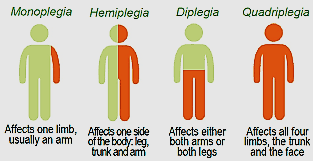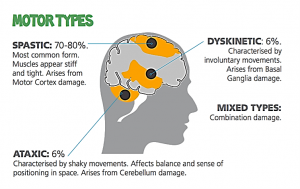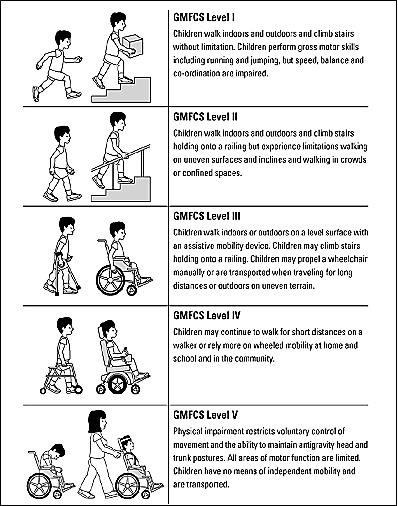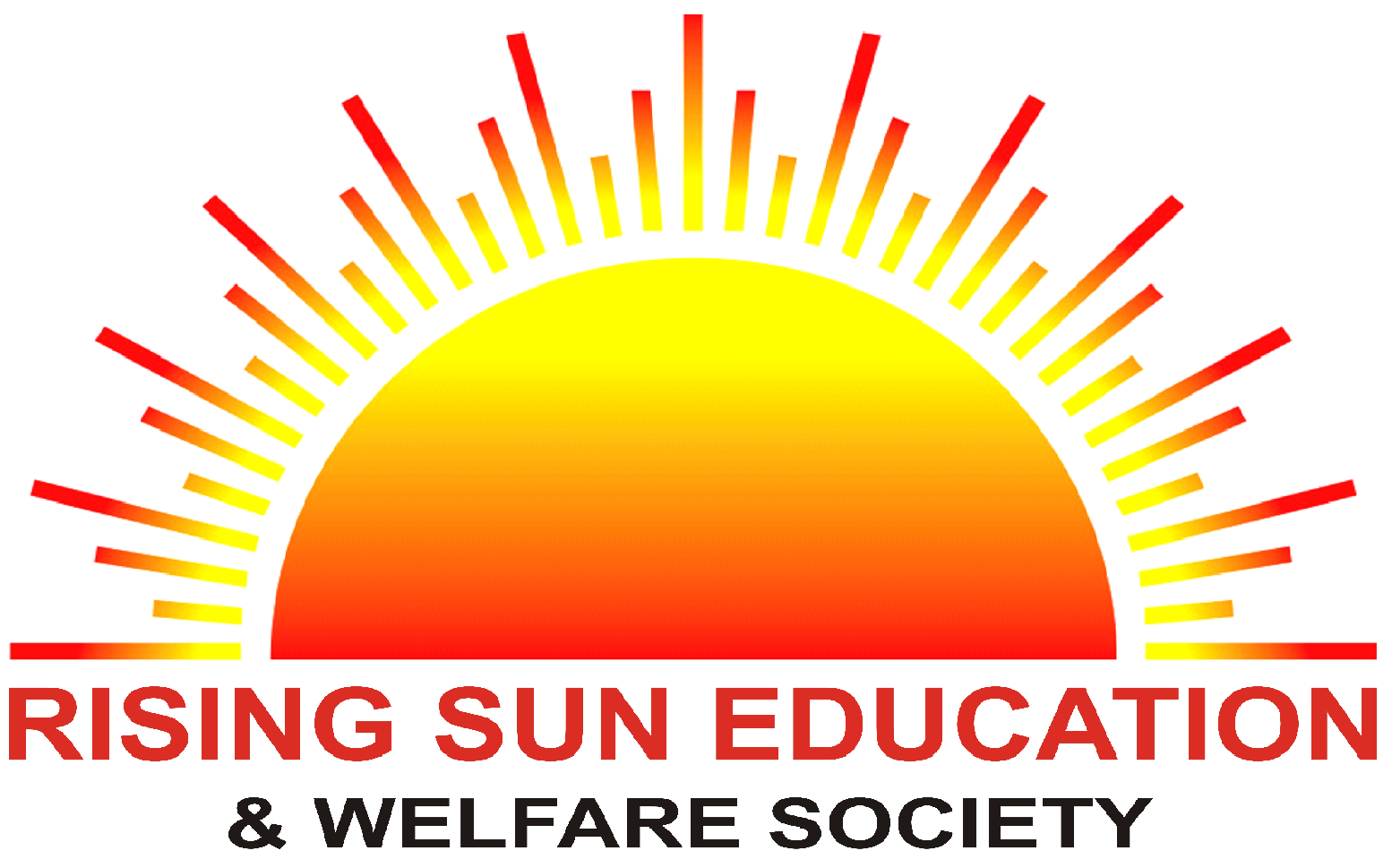Cerebral Palsy
Guidelines for Parents
Cerebral palsy, as the name implies, is the disease caused by damage in the specific muscles of brain involved with movement of muscles. The damage may be caused before, during or right after birth due to various reasons.
The physical symptoms are mostly evident in the early years as the child is unable to achieve motor milestones at the appropriate age. They experience difficulty rolling over, sitting, crawling, walking and even smiling (depending on the nature and severity of the illness).
Signs of cerebral palsy
The signs of cerebral palsy may vary from one individual to another based on the degree of damage to the brain muscles. Moreover, symptoms may change over time. Apart from difficulty in achieving developmental milestones appropriately, weakness in one or more than one limb, difficulty standing or walking, walking on tiptoe, poor fine motor skills, inability to maintain body balance, leg dragging, excessive drooling and involuntary body movements are commonly observed.

Causes of Cerebral Palsy
According to the researched, the leading causes of cerebral palsy include head injury or damage to the brain before, during or after birth, jaundice or rubella (measles) in early childhood, RH incompatibility, pre-mature birth, and stroke at an early age due to known or unknown reasons.
Identifying Severity level of cerebral palsy
The severity level Cerebral Palsy is categorized as
- Mild (children may have clumsy appearance but are able to walk)
- Moderate (child walks with a limp; may need cane or a leg brace)
- Severe (affect is visible on all areas of physical abilities; may have to use wheelchair or supportive equipment)
- Profound (children are completely dependent on others for movement and care).
How is Cerebral Palsy diagnosed?
There are different ways to diagnose and verify the diagnosis of cerebral palsy. Doctors use more than one method to confirm the diagnosis and the severity. Mostly, testing motor skills and the body reflexes give a clear indication of cerebral palsy. Medical records are an efficient way of verifying the diagnosis. Moreover, specialized screening and diagnostic tests are also performed by professionals to understand the condition.
Cerebral palsy is not a progressive disease. Deterioration in the condition may be due to other comorbid illness. Moreover, it cannot be cures rather it can be managed through various therapy techniques.
Types of cerebral Palsy
- Spastic Cerebral Palsy:
- Spastic Quadriplegia,
- Spastic Diplegia,
- Spastic Hemiplegia
- Athetoid Cerebral Palsy (Dyskinetic)
- Ataxic Cerebral Palsy
- Hypotonic cerebral palsy
- Mixed


The movement problem
The Gross Motor Function Classification System (GMFCS) is a five level classification to identify the level of gross motor function in children having cerebral palsy is explained below:
- Children with GMFCS levels I and II walk independently
- Children with GMFCS level III require a hand-held mobility aid such as crutches or a walker and may use a wheelchair for distances.
- Children with GMFCS levels IV and V have more limitations in self-mobility and require a wheelchair.
- GMFCS level can be accurately assessed from the time a child is two years of age.
- Knowing a child’s GMFCS level can help the orthopaedic team predict the likelihood a child will have certain orthopaedic problems as they grow.

Complications
Generally the complications experienced by children with cerebral palsy include Tightness in muscles, muscle Spasm, deformation of muscles, Joint Stiffness, emotional disturbance, secondary respiratory complications and Pressure sores. Complications mostly increase due to the presence of some other illness along with cerebral palsy.
Will my child’s condition worsen?
The damage done to the brain does not worsen or spread to other parts to the brain. However, as it has been noted that as the child grows, the condition appears to be deteriorating. Keeping the fact in mind that the deterioration is not due to the worsening of the brain injury, there are many other reasons for this issue.
In children with cerebral palsy, bones grow faster than muscles. As the muscles are weak and stiff the child has difficulty moving the muscles through their full range of motions. Due to the faster growth of the bones, the muscle become tighter gradually. This situation gets serious during the growth spurts of the children. The conditions like tip toe walking become more apparent as the child walks on toes (bones) and not on the heel cord as they become very tight and painful too.
Gradually, as children begin to move their muscles in later age, the bones also change (hence the process is called as bone remodelling). After the growth spurt periods are over, as the children have decreased mobility due to highly stiffed muscles, bone development reduces gradually and when bones do not develop as expected, the forces going through a child’s bones when they stand and move are different. These abnormal forces can cause the bones to “remodel” in a non-typical way leading to deformities. To prevent this condition i.e., bone deformities, supportive equipment is often recommended even by an early intervention expert or physiotherapists which may include orthotics, walker, crutches, standing frames, and wheelchairs specially designed for the individuals with cerebral palsy.
Maintaining a healthy body weight is very important for these individuals. The weakness and size of muscles and bones affect their body. As they gain weight, the pressure on muscles gets increased as they mobilize. The muscles are not strong enough (despite their size) to aid the individual in standing and walking. This means that standing and walking may require more energy as children grow and become more difficult. For this reason, children should maintain a healthy body weight.
Management of Cerebral Palsy
No single modality of therapy has been found to manage the cerebral palsy effectively. Moreover there is no single treatment that is effective for every child. Hence a combination approach is applied using following techniques suitable according to the severity and type of the child’s condition.
- Physical therapy,
- occupational therapy,
- sensory integration therapy
- hydrotherapy
- oral medications
- botulinum toxin
- speech therapy,
- behavioral therapy,
- drugs used to control seizures and muscle spasms,
- special braces or orthotics can compensate for muscle imbalance,
- splinting to improve muscle function,
- orthopedic surgery to correct contractures or improve function
- counseling for emotional and psychological needs
Rehabilitation
The treatment of cerebral palsy is prolonged. It is often suggested that a special school setting with the provision of facilities such as physiotherapy and occupational therapy is best for these children. The children may get special education according to their mental age. They also need pre-vocational training using the equipment suitable according to their special needs. Trained in ADL’s (activities of daily living skills), IADL’s (instrumental activities of daily living skills) and self-help skills is also taught at the special school. All these trainings help the children in their re-habilitation.
Speech & Language Therapy
Some children with cerebral palsy also experience speech and language related issue too. They are often referred to an audiologist and a speech therapist for assessment and management to teach them communication skills such as talking, sign language or using the communication aid.
Occupational Therapy and Sensory Integration Therapy
The sensory-perceptual-motor coordination is very important for children with cerebral palsy. It is necessary in order to perform activities of daily living. Occupational therapists are the experts who train these children and teach children to use their arms, hands and upper body in a better way. Occupational therapy makes these children familiar with the use of the special equipment (according to their needs) to make some everyday jobs easy.
Recreational Therapy and sports
Recreation is the fundamental right of every child. Recreational therapists work with children on sports skills or other leisure activities, especially those that involve motor movements.
Cerebral Palsy
Guidelines for Parents
Cerebral palsy, as the name implies, is the disease caused by damage in the specific muscles of brain involved with movement of muscles. The damage may be caused before, during or right after birth due to various reasons.
The physical symptoms are mostly evident in the early years as the child is unable to achieve motor milestones at the appropriate age. They experience difficulty rolling over, sitting, crawling, walking and even smiling (depending on the nature and severity of the illness).
Signs of cerebral palsy
The signs of cerebral palsy may vary from one individual to another based on the degree of damage to the brain muscles. Moreover, symptoms may change over time. Apart from difficulty in achieving developmental milestones appropriately, weakness in one or more than one limb, difficulty standing or walking, walking on tiptoe, poor fine motor skills, inability to maintain body balance, leg dragging, excessive drooling and involuntary body movements are commonly observed.

Causes of Cerebral Palsy
According to the researched, the leading causes of cerebral palsy include head injury or damage to the brain before, during or after birth, jaundice or rubella (measles) in early childhood, RH incompatibility, pre-mature birth, and stroke at an early age due to known or unknown reasons.
Identifying Severity level of cerebral palsy
The severity level Cerebral Palsy is categorized as
- Mild (children may have clumsy appearance but are able to walk)
- Moderate (child walks with a limp; may need cane or a leg brace)
- Severe (affect is visible on all areas of physical abilities; may have to use wheelchair or supportive equipment)
- Profound (children are completely dependent on others for movement and care).
How is Cerebral Palsy diagnosed?
There are different ways to diagnose and verify the diagnosis of cerebral palsy. Doctors use more than one method to confirm the diagnosis and the severity. Mostly, testing motor skills and the body reflexes give a clear indication of cerebral palsy. Medical records are an efficient way of verifying the diagnosis. Moreover, specialized screening and diagnostic tests are also performed by professionals to understand the condition.
Cerebral palsy is not a progressive disease. Deterioration in the condition may be due to other comorbid illness. Moreover, it cannot be cures rather it can be managed through various therapy techniques.
Types of cerebral Palsy
- Spastic Cerebral Palsy:
- Spastic Quadriplegia,
- Spastic Diplegia,
- Spastic Hemiplegia
- Athetoid Cerebral Palsy (Dyskinetic)
- Ataxic Cerebral Palsy
- Hypotonic cerebral palsy
- Mixed

The movement problem
The Gross Motor Function Classification System (GMFCS) is a five level classification to identify the level of gross motor function in children having cerebral palsy is explained below:
- Children with GMFCS levels I and II walk independently
- Children with GMFCS level III require a hand-held mobility aid such as crutches or a walker and may use a wheelchair for distances.
- Children with GMFCS levels IV and V have more limitations in self-mobility and require a wheelchair.
- GMFCS level can be accurately assessed from the time a child is two years of age.
- Knowing a child’s GMFCS level can help the orthopaedic team predict the likelihood a child will have certain orthopaedic problems as they grow.

Complications
Generally the complications experienced by children with cerebral palsy include Tightness in muscles, muscle Spasm, deformation of muscles, Joint Stiffness, emotional disturbance, secondary respiratory complications and Pressure sores. Complications mostly increase due to the presence of some other illness along with cerebral palsy.
Will my child’s condition worsen?
The damage done to the brain does not worsen or spread to other parts to the brain. However, as it has been noted that as the child grows, the condition appears to be deteriorating. Keeping the fact in mind that the deterioration is not due to the worsening of the brain injury, there are many other reasons for this issue.
In children with cerebral palsy, bones grow faster than muscles. As the muscles are weak and stiff the child has difficulty moving the muscles through their full range of motions. Due to the faster growth of the bones, the muscle become tighter gradually. This situation gets serious during the growth spurts of the children. The conditions like tip toe walking become more apparent as the child walks on toes (bones) and not on the heel cord as they become very tight and painful too.
Gradually, as children begin to move their muscles in later age, the bones also change (hence the process is called as bone remodelling). After the growth spurt periods are over, as the children have decreased mobility due to highly stiffed muscles, bone development reduces gradually and when bones do not develop as expected, the forces going through a child’s bones when they stand and move are different. These abnormal forces can cause the bones to “remodel” in a non-typical way leading to deformities. To prevent this condition i.e., bone deformities, supportive equipment is often recommended even by an early intervention expert or physiotherapists which may include orthotics, walker, crutches, standing frames, and wheelchairs specially designed for the individuals with cerebral palsy.
Maintaining a healthy body weight is very important for these individuals. The weakness and size of muscles and bones affect their body. As they gain weight, the pressure on muscles gets increased as they mobilize. The muscles are not strong enough (despite their size) to aid the individual in standing and walking. This means that standing and walking may require more energy as children grow and become more difficult. For this reason, children should maintain a healthy body weight.
Management of Cerebral Palsy
No single modality of therapy has been found to manage the cerebral palsy effectively. Moreover there is no single treatment that is effective for every child. Hence a combination approach is applied using following techniques suitable according to the severity and type of the child’s condition.
- Physical therapy,
- occupational therapy,
- sensory integration therapy
- hydrotherapy
- oral medications
- botulinum toxin
- speech therapy,
- behavioral therapy,
- drugs used to control seizures and muscle spasms,
- special braces or orthotics can compensate for muscle imbalance,
- splinting to improve muscle function,
- orthopedic surgery to correct contractures or improve function
- counseling for emotional and psychological needs
Rehabilitation
The treatment of cerebral palsy is prolonged. It is often suggested that a special school setting with the provision of facilities such as physiotherapy and occupational therapy is best for these children. The children may get special education according to their mental age. They also need pre-vocational training using the equipment suitable according to their special needs. Trained in ADL’s (activities of daily living skills), IADL’s (instrumental activities of daily living skills) and self-help skills is also taught at the special school. All these trainings help the children in their re-habilitation.
Speech & Language Therapy
Some children with cerebral palsy also experience speech and language related issue too. They are often referred to an audiologist and a speech therapist for assessment and management to teach them communication skills such as talking, sign language or using the communication aid.
Occupational Therapy and Sensory Integration Therapy
The sensory-perceptual-motor coordination is very important for children with cerebral palsy. It is necessary in order to perform activities of daily living. Occupational therapists are the experts who train these children and teach children to use their arms, hands and upper body in a better way. Occupational therapy makes these children familiar with the use of the special equipment (according to their needs) to make some everyday jobs easy.
Recreational Therapy and sports
Recreation is the fundamental right of every child. Recreational therapists work with children on sports skills or other leisure activities, especially those that involve motor movements.
